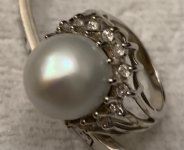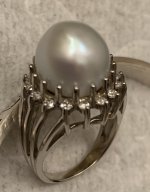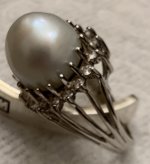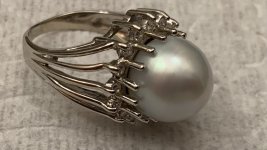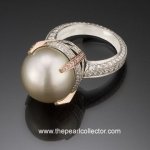I inherited this ring from my grandmother. My mother had it made from a pearl she got from a diver in Indonesia. He apparently spent a lot of time diving for pearls (for meat?). He has found this one while diving and sold it to my mother. Is it really natural and how can one tell? It is actually lighter than these pics show but is greyish
You are using an out of date browser. It may not display this or other websites correctly.
You should upgrade or use an alternative browser.
You should upgrade or use an alternative browser.
Natural SSP?
- Thread starter Pegleit
- Start date
jshepherd
Well-known member
- Joined
- Jun 22, 2004
- Messages
- 6,165
It would need to be tested to determine whether or not it's natural, but it could be! If you're able to remove it from the setting, you could also check for a nucleus down the drill hole. If there is an obvious one you'll know it's cultured. If you can't see one, then it's worth testing.
Thanks! I just had it sized so I will ask the jeweler. He removed it to size the ring. Could I also see one by candling it?It would need to be tested to determine whether or not it's natural, but it could be! If you're able to remove it from the setting, you could also check for a nucleus down the drill hole. If there is an obvious one you'll know it's cultured. If you can't see one, then it's worth testing.
Lagoon Island Pearls
Well-known member
- Joined
- Dec 8, 2009
- Messages
- 2,007
It may or it may not be conclusive as Jeremy mentioned, but it's worth a try to see if there are common or distinct features.Could I also see one by candling it?
Thank you both! I am going on a trip but when I get back, I will ask the jeweler if he saw anything when he sized it. I don’t trust my skills in getting it out of it’s setting now. If it is natural, is it something I should have appraised and insured? It’s fairly large - maybe 11/12mm?
Lagoon Island Pearls
Well-known member
- Joined
- Dec 8, 2009
- Messages
- 2,007
Appraisal is subjective and you'd find a wide range of opinions in the absence of true expertise.If it is natural, is it something I should have appraised and insured? It’s fairly large - maybe 11/12mm?
11-12mm is quite large for a natural pearl. That's bad and good. Bad being it's likely cultured, good being it will have some value if deemed natural. The provenance of this piece is questionable. There's no known harvest history nor documentation accompanying this, therefore presumptions cannot be factored. I would only recommend lab certification if there was clear evidence of marked occlusions at the nucleus consistent with natural pearls.
This is why I'd urge candling from at least 2 two aspects, with 3 preferred. X,Y, and Z if you will.
jshepherd
Well-known member
- Joined
- Jun 22, 2004
- Messages
- 6,165
This is the finest large natural I've ever seen. I saw it before the ring was made, and it did have a bit of a button shape to it. It was certified by SSEF before the ring was built around it. The last I heard about the ring, it was going up for auction. My friend and owner of the ring was expecting a significant price.

 pin.it
pin.it

Natural Oyster Pearl Photo Gallery | Natural pearl jewelry, Natural oyster pearl, White pearl jewelry
Apr 1, 2013 - This Pin was discovered by The Pearl Collector. Discover (and save!) your own Pins on Pinterest
Attachments
Thank you Lagoon Island Pearls - I will most definitely do that! For now, it’s in the bank box til we get back. I may be all wet for the size - I’m not very good with size estimates. I just know it’s bigger than my Akoya pearls, which are 8mm, (I think, maybe 7). I really have to buy a gauge!Appraisal is subjective and you'd find a wide range of opinions in the absence of true expertise.
11-12mm is quite large for a natural pearl. That's bad and good. Bad being it's likely cultured, good being it will have some value if deemed natural. The provenance of this piece is questionable. There's no known harvest history nor documentation accompanying this, therefore presumptions cannot be factored. I would only recommend lab certification if there was clear evidence of marked occlusions at the nucleus consistent with natural pearls.
This is why I'd urge candling from at least 2 two aspects, with 3 preferred. X,Y, and Z if you will.
Beautiful! How big is it, if I may ask..? Also SSEF? South Sea ?? Thanks!This is the finest large natural I've ever seen. I saw it before the ring was made, and it did have a bit of a button shape to it. It was certified by SSEF before the ring was built around it. The last I heard about the ring, it was going up for auction. My friend and owner of the ring was expecting a significant price.

Natural Oyster Pearl Photo Gallery | Natural pearl jewelry, Natural oyster pearl, White pearl jewelry
Apr 1, 2013 - This Pin was discovered by The Pearl Collector. Discover (and save!) your own Pins on Pinterestpin.it
Forgive me but I am very novice when it comes to pearls. How do you mean, “marked occlusions at the nucleus consistent with natural pearls”? I always thought that natural pearls had no implanted nucleus? There is a natural one? Thanks!Appraisal is subjective and you'd find a wide range of opinions in the absence of true expertise.
11-12mm is quite large for a natural pearl. That's bad and good. Bad being it's likely cultured, good being it will have some value if deemed natural. The provenance of this piece is questionable. There's no known harvest history nor documentation accompanying this, therefore presumptions cannot be factored. I would only recommend lab certification if there was clear evidence of marked occlusions at the nucleus consistent with natural pearls.
This is why I'd urge candling from at least 2 two aspects, with 3 preferred. X,Y, and Z if you will.
jshepherd
Well-known member
- Joined
- Jun 22, 2004
- Messages
- 6,165
I don't remember the exact size, but it was large - probably 12 mm +.
If I recall, he purchased it from a fisherman in South America. He gets most of the natural pearls he carries from South and Central America.
SSEF (https://www.ssef.ch/) is the type of certification needed to sell high-end natural pearls.
If I recall, he purchased it from a fisherman in South America. He gets most of the natural pearls he carries from South and Central America.
SSEF (https://www.ssef.ch/) is the type of certification needed to sell high-end natural pearls.
I don't remember the exact size, but it was large - probably 12 mm +.
If I recall, he purchased it from a fisherman in South America. He gets most of the natural pearls he carries from South and Central America.
SSEF (https://www.ssef.ch/) is the type of certification needed to sell high-end natural pearls.
He got the SSEF certification AFTER he got the pearl, then? If mine is natural, I can do the same? Thanks again!
jshepherd
Well-known member
- Joined
- Jun 22, 2004
- Messages
- 6,165
He was confident the pearl was natural. He only deals in natural pearls and often buys them from local fishermen. In order to put the pearl on auction he needed the SSEF certificate. If you're stateside, GIA would be your best immediate option for a natural certification. If it is a large natural and you intend to sell it, SSEF certification would be your next step.
Lagoon Island Pearls
Well-known member
- Joined
- Dec 8, 2009
- Messages
- 2,007
I would normally refer you to this thread, but it seems the images are different from what I've posted. Forum software update bug, perhaps?Forgive me but I am very novice when it comes to pearls. How do you mean, “marked occlusions at the nucleus consistent with natural pearls”? I always thought that natural pearls had no implanted nucleus? There is a natural one? Thanks!
Candling reveals the nucleus. There are marked differences between natural and cultural formation.
Views of bead nucleated pearls typically show juvenile growth in the near subsurface, as opposed to the centre or throughout in natural pearls. Streaks, blotches or foreign material may be present, supporting natural formation. The bisected lines of growth fronts of shell beads are sometimes visible.
Thank you! I don’t really intend to sell it, only to know if I should be insuring it. GIA would give me an idea of that, I assume?He was confident the pearl was natural. He only deals in natural pearls and often buys them from local fishermen. In order to put the pearl on auction he needed the SSEF certificate. If you're stateside, GIA would be your best immediate option for a natural certification. If it is a large natural and you intend to sell it, SSEF certification would be your next step.
Thanks much! Such good info here, it’s a great site. I will look for that. If it looks like it might be natural, GIA would be next step? Thanks to you all for such great information and advice!I would normally refer you to this thread, but it seems the images are different from what I've posted. Forum software update bug, perhaps?
Candling reveals the nucleus. There are marked differences between natural and cultural formation.
Views of bead nucleated pearls typically show juvenile growth in the near subsurface, as opposed to the centre or throughout in natural pearls. Streaks, blotches or foreign material may be present, supporting natural formation. The bisected lines of growth fronts of shell beads are sometimes visible.
Lagoon Island Pearls
Well-known member
- Joined
- Dec 8, 2009
- Messages
- 2,007
GIA is a good option, as is SSEF. Both use well defined x-ray views to examine an object. In this case, likely different views to determine the presence of a shell bead. In the absence of that, they'd look at the inner volume for the presence of grafted tissue, geometry of growth stages, foreign matter etc. Even then, they may rule inconclusive. This why candling in a home setting is a good thing as many times it tells you all you'll need to know.Thanks much! Such good info here, it’s a great site. I will look for that. If it looks like it might be natural, GIA would be next step? Thanks to you all for such great information and advice!
Keeping in mind, it's exceedingly difficult to back-trace origin without provenance or sophisticated DNA tracking. A lab can generally determine species, but location not so much unless there are irrefutable exemplars in their possession. Pearls from identical locations can have unlike features. I'd expect both labs to have several of the SS variety. Even if they could name a locale, there are other factors needing to be ruled out (as opposed to confirming presence thereof). Keshi pearls tend to be smaller than their nucleated counterparts, but one can't say larger never happens either. A single oyster on a farm which was misplaced for a year or more (for example) could produce huge keshi pearls.
Like amber, I'd want to see the proverbial insect at the nucleus. I've seen numerous views of both pearl types across many species and locations. In the case of cultured pearls, the nuclei typically appear similar to one another, where in natural pearls they are almost always markedly different. Unique, even.
CortezPearls
PG Forum Admin
- Joined
- Aug 26, 2005
- Messages
- 3,667
I agree 100%GIA is a good option, as is SSEF. Both use well defined x-ray views to examine an object. In this case, likely different views to determine the presence of a shell bead. In the absence of that, they'd look at the inner volume for the presence of grafted tissue, geometry of growth stages, foreign matter etc. Even then, they may rule inconclusive. This why candling in a home setting is a good thing as many times it tells you all you'll need to know.
Keeping in mind, it's exceedingly difficult to back-trace origin without provenance or sophisticated DNA tracking. A lab can generally determine species, but location not so much unless there are irrefutable exemplars in their possession. Pearls from identical locations can have unlike features. I'd expect both labs to have several of the SS variety. Even if they could name a locale, there are other factors needing to be ruled out (as opposed to confirming presence thereof). Keshi pearls tend to be smaller than their nucleated counterparts, but one can't say larger never happens either. A single oyster on a farm which was misplaced for a year or more (for example) could produce huge keshi pearls.
Like amber, I'd want to see the proverbial insect at the nucleus. I've seen numerous views of both pearl types across many species and locations. In the case of cultured pearls, the nuclei typically appear similar to one another, where in natural pearls they are almost always markedly different. Unique, even.
Thanks so much! I will candle it at home and see what comes of it. If I can, I will post results here. (not sure if my photo Skills will allow)I agree 100%
Last edited:
Similar threads
- Replies
- 6
- Views
- 976
- Replies
- 14
- Views
- 1K
- Replies
- 2
- Views
- 213
- Replies
- 6
- Views
- 958
- Replies
- 3
- Views
- 473

